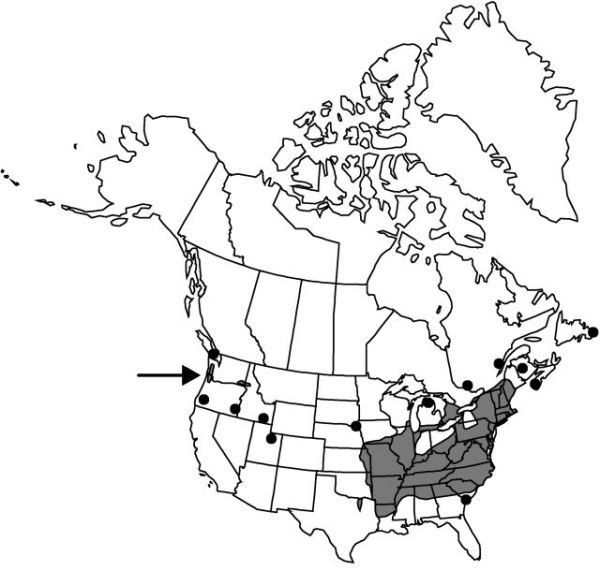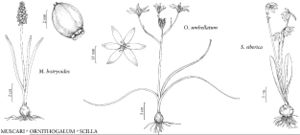Difference between revisions of "Ornithogalum umbellatum"
Sp. Pl. 1: 307. 1753.
FNA>Volume Importer |
imported>Volume Importer |
||
| (2 intermediate revisions by 2 users not shown) | |||
| Line 8: | Line 8: | ||
}} | }} | ||
|common_names=Nap-at-noon;sleepy dick | |common_names=Nap-at-noon;sleepy dick | ||
| + | |special_status={{Treatment/ID/Special_status | ||
| + | |code=W2 | ||
| + | |label= | ||
| + | }}{{Treatment/ID/Special_status | ||
| + | |code=W1 | ||
| + | |label= | ||
| + | }}{{Treatment/ID/Special_status | ||
| + | |code=I | ||
| + | |label=Introduced | ||
| + | }}{{Treatment/ID/Special_status | ||
| + | |code=F | ||
| + | |label=Illustrated | ||
| + | }} | ||
|basionyms= | |basionyms= | ||
|synonyms= | |synonyms= | ||
| Line 23: | Line 36: | ||
|habitat=Roadsides, open forests, waste places, dumps | |habitat=Roadsides, open forests, waste places, dumps | ||
|elevation=0–1500 m | |elevation=0–1500 m | ||
| − | |distribution=B.C.;N.B.;Nfld. and Labr.(Nfld.);N.S.;Ont.;Que.;Ala.;Ark.;Conn.;Del.;D.C.;Ga.;Idaho;Ill.;Ind.;Iowa;Kans.;Ky.;La.;Maine;Md.;Mass.;Mich.;Miss.;Mo.;Nebr.;N.H.;N.J.;N.Y.;N.C.;Ohio;Okla.;Oreg.;Pa.;R.I.;S.C.;S.Dak.;Tenn.;Tex.;Utah;Vt.;Va.;Wash.;W.Va.;Wis.;Europe;n Africa;Asia;Middle East;expected elsewhere. | + | |distribution=B.C.;N.B.;Nfld. and Labr. (Nfld.);N.S.;Ont.;Que.;Ala.;Ark.;Conn.;Del.;D.C.;Ga.;Idaho;Ill.;Ind.;Iowa;Kans.;Ky.;La.;Maine;Md.;Mass.;Mich.;Miss.;Mo.;Nebr.;N.H.;N.J.;N.Y.;N.C.;Ohio;Okla.;Oreg.;Pa.;R.I.;S.C.;S.Dak.;Tenn.;Tex.;Utah;Vt.;Va.;Wash.;W.Va.;Wis.;Europe;n Africa;Asia;Middle East;expected elsewhere. |
| + | |introduced=true | ||
|discussion=<p>Planted as a garden ornamental, <i>Ornithogalum umbellatum</i> produces many offsetting bulblets that are transported in soil and can become rampant weeds. Adding to the vegetative vigor of this species may be its aneuploid-polyploid karyology (T. W. J. Gadella and L. van Raamsdonk 1981; L. van Raamsdonk 1984). The flowers are noteworthy for their regularity in opening just before noon and closing again before sunset.</p><!-- | |discussion=<p>Planted as a garden ornamental, <i>Ornithogalum umbellatum</i> produces many offsetting bulblets that are transported in soil and can become rampant weeds. Adding to the vegetative vigor of this species may be its aneuploid-polyploid karyology (T. W. J. Gadella and L. van Raamsdonk 1981; L. van Raamsdonk 1984). The flowers are noteworthy for their regularity in opening just before noon and closing again before sunset.</p><!-- | ||
--><p>Two digitalis-like glycosides, convallatoxin and convalloside, poisonous to humans and livestock, are found throughout the plant, but are concentrated in the bulbs and the flowers (W. H. Blackwell 1990; K. F. Lampe and M. A. McCann 1985; D. G. Spoerke Jr. and S. C. Smolinske 1990).</p> | --><p>Two digitalis-like glycosides, convallatoxin and convalloside, poisonous to humans and livestock, are found throughout the plant, but are concentrated in the bulbs and the flowers (W. H. Blackwell 1990; K. F. Lampe and M. A. McCann 1985; D. G. Spoerke Jr. and S. C. Smolinske 1990).</p> | ||
| Line 43: | Line 57: | ||
|habitat=Roadsides, open forests, waste places, dumps | |habitat=Roadsides, open forests, waste places, dumps | ||
|elevation=0–1500 m | |elevation=0–1500 m | ||
| − | |distribution=B.C.;N.B.;Nfld. and Labr.(Nfld.);N.S.;Ont.;Que.;Ala.;Ark.;Conn.;Del.;D.C.;Ga.;Idaho;Ill.;Ind.;Iowa;Kans.;Ky.;La.;Maine;Md.;Mass.;Mich.;Miss.;Mo.;Nebr.;N.H.;N.J.;N.Y.;N.C.;Ohio;Okla.;Oreg.;Pa.;R.I.;S.C.;S.Dak.;Tenn.;Tex.;Utah;Vt.;Va.;Wash.;W.Va.;Wis.;Europe;n Africa;Asia;Middle East;expected elsewhere. | + | |distribution=B.C.;N.B.;Nfld. and Labr. (Nfld.);N.S.;Ont.;Que.;Ala.;Ark.;Conn.;Del.;D.C.;Ga.;Idaho;Ill.;Ind.;Iowa;Kans.;Ky.;La.;Maine;Md.;Mass.;Mich.;Miss.;Mo.;Nebr.;N.H.;N.J.;N.Y.;N.C.;Ohio;Okla.;Oreg.;Pa.;R.I.;S.C.;S.Dak.;Tenn.;Tex.;Utah;Vt.;Va.;Wash.;W.Va.;Wis.;Europe;n Africa;Asia;Middle East;expected elsewhere. |
|introduced=true | |introduced=true | ||
|reference=None | |reference=None | ||
|publication title=Sp. Pl. | |publication title=Sp. Pl. | ||
|publication year=1753 | |publication year=1753 | ||
| − | |special status= | + | |special status=W2;W1;Introduced;Illustrated |
| − | |source xml=https:// | + | |source xml=https://bitbucket.org/aafc-mbb/fna-data-curation/src/2e0870ddd59836b60bcf96646a41e87ea5a5943a/coarse_grained_fna_xml/V26/V26_638.xml |
|genus=Ornithogalum | |genus=Ornithogalum | ||
|species=Ornithogalum umbellatum | |species=Ornithogalum umbellatum | ||
Latest revision as of 21:16, 5 November 2020
Plants (10–)20–30(–40) cm; bulbs renewed each year, 1–2 × 1–2.5(–3.5) cm; bulblets numerous. Leaves 4–6(–9); blade with white adaxial stripe, 20–30 cm × 3–5(–8) mm. Scape 1–3 dm. Inflorescences corymbose, (4–)8–20-flowered, flat-topped; bracts to 4 cm. Flowers erect; perianth opening flat or bowl-shaped in sun, closing at night, remaining closed on cloudy days; tepals white with wide green abaxial stripe, lanceolate to oblong-lanceolate, 15–22(–30) × 7–8 mm; stamens: outer 5–7 × 2–3 mm, inner 6–8 × 2–3 mm; filaments simple, flattened; anthers 2–4 mm; ovary ovoid to obovoid, strongly 6-angled, 5–6 mm; style 3–4 mm; lower pedicels 2–6 cm. Capsules oblong-ovoid. 2n = 18, 20, 27, 28, 35, 36, 42, 44, 45, 54, 72, 90, 108.
Phenology: Flowering spring.
Habitat: Roadsides, open forests, waste places, dumps
Elevation: 0–1500 m
Distribution

Introduced; B.C., N.B., Nfld. and Labr. (Nfld.), N.S., Ont., Que., Ala., Ark., Conn., Del., D.C., Ga., Idaho, Ill., Ind., Iowa, Kans., Ky., La., Maine, Md., Mass., Mich., Miss., Mo., Nebr., N.H., N.J., N.Y., N.C., Ohio, Okla., Oreg., Pa., R.I., S.C., S.Dak., Tenn., Tex., Utah, Vt., Va., Wash., W.Va., Wis., Europe, n Africa, Asia, Middle East, expected elsewhere.
Discussion
Planted as a garden ornamental, Ornithogalum umbellatum produces many offsetting bulblets that are transported in soil and can become rampant weeds. Adding to the vegetative vigor of this species may be its aneuploid-polyploid karyology (T. W. J. Gadella and L. van Raamsdonk 1981; L. van Raamsdonk 1984). The flowers are noteworthy for their regularity in opening just before noon and closing again before sunset.
Two digitalis-like glycosides, convallatoxin and convalloside, poisonous to humans and livestock, are found throughout the plant, but are concentrated in the bulbs and the flowers (W. H. Blackwell 1990; K. F. Lampe and M. A. McCann 1985; D. G. Spoerke Jr. and S. C. Smolinske 1990).
Selected References
None.
